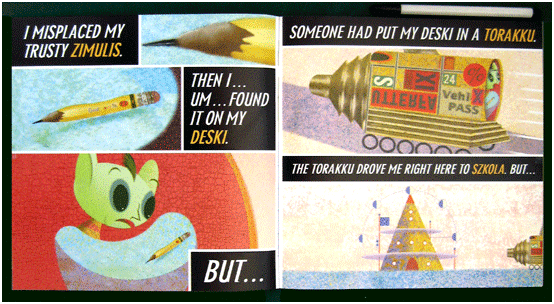“The Cue to Reading” Series (Article 1): The Three Cueing Systems of Reading
Zimulis.
What is this word? How do you say it? How would it fit in a sentence? What is it describing? Do you have ANY ideas?
Does this help…“I misplaced my trusty zimulis”?
Now you know that a zimulis is a noun. Whatever it is, it’s “trusty,” so maybe it is some type of electronic device or a tool?
Now look at this photo:
From Jon Scieszka’s book,“Baloney, Henry P.”
From this photo, you can finally determine that a “zimulis” is a pencil!
We’ve just wandered through the three cueing systems our brains use when we read. Every time we read, our brains are aligning cues from these three systems to process words and their meaning. The cues are influenced by the unique combination of letters, words, and the situations in which we encounter them.
Those three systems are:
- Visual (graphophonic)
- Grammatical (syntax)
- Contextual (semantics/meaning)
Let’s break it down. At first, your only cue was the string of letters: z-i-m-u-l-i-s. This is a visual cue. The second example put the word in a full sentence (“I misplaced my trusty zimulis.”) and provided a grammar cue. Finally, the picture helped you determine its meaning by providing a context for the sentence. To summarize:
- VISUAL CUE = the string of letters: z-i-m-u-l-i-s.
- GRAMMATICAL CUE = identifying the part of speech by reading the word in a sentence. (“I misplaced my trusty zimulis.”)
- CONTEXTUAL CUE = the setting and conditions in which that sentence was used. (In this case, an illustration provided the meaning.)
These cueing systems are the core to everything I understand about reading and every decision I make when I teach reading. (As a reading teacher, I make hundreds of “on-the-spot” decisions while I am coaching a struggling reader.) My understanding of these systems is specifically what helped me recognize a problem with my son’s reading at such an early age…well before any of his teachers detected a problem.
In theory, this is not a big secret; I just Googled “three cueing systems of reading” and got over 133,000 results! However, I have been completely shocked by the lack of understanding I encountered among my son’s teachers and administrators. Judging by the dozens of similar stories I have heard in only the last few months, my experience does not seem to be unique. Training in these fundamental aspects of the reading process is very inadequate!
Why are the Cueing Systems So Important?
You cannot truly teach a struggling reader if you do not know what systems he is using well and in what areas he is deficient. Without this insight, all instruction is a stab in the dark. Sometimes, teachers get lucky and get it right.
Sometimes, they don’t.
How Do You Identify The Breakdown?
A “miscue analysis” can be done to analyze the cueing systems a student is using and where they may be deficient. In next week’s article, I will explain this process in detail. Meanwhile, pay attention to your own use of the cueing systems over the next week and think about what cueing system you rely upon the MOST.
-Susan Kruger
EB 080817
Six Steps
Conquer the Chaos
Get Our Free Guide & Information on...

"*" indicates required fields
Get Our FREE Curriculum Guide!
The SOAR® Curriculum
The most critical learning, organizing, and communication skills needed for school. Learn more here.
Who’s Using SOAR®?
SOAR® Guarantee
Click here to learn more.





